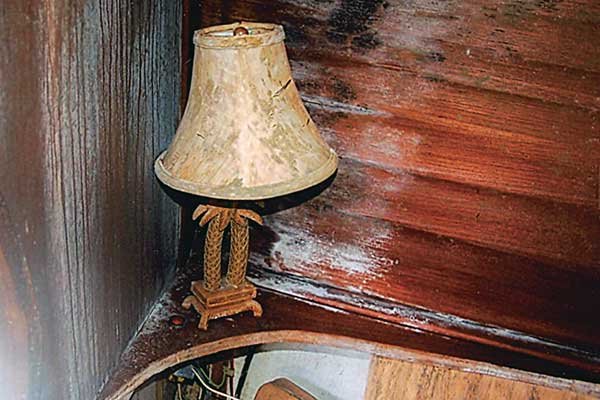
Preventing Mold And Mildew
If you store your boat or leave it inactive for periods of time, the Mold Battle is real.
Here ‘s a great article penned by Charles Fort
Most boat insurance policies don't cover mold damage. So it can be a rude awakening to open your boat in the spring and be greeted with a dank, musty smell or an interior full of mildewy cushions, carpets, and headliners. Mold spreads by forming spores, and every boat, charter, recreation, or luxury has them. The key is to deny them what they want so they can't grow.
Keep Water Out
It's easier to prevent mold and mildew than to stop it. Mold is accelerated by warmth and high humidity and, once formed, can survive for years, even if conditions change. And as anyone who's waited too long to clean out a refrigerator can attest, mold also thrives in cooler weather. Even in frigid climates, the interior of a boat can reach temperatures that will support mold when the sun shines on the hull and in the early days of spring.
A single water leak can start spores growing. Rain leaking through hatches and portlights will make a boat's interior a mold haven, so the first thing to do is find and seal leaks. Portlights and windows are probably the primary leak spots on a boat, followed by loose stanchions. On sailboats, chainplates that penetrate the deck are a common problem area, as are deck-stepped masts. Leaking deck hardware (cleats, rails, and windlasses) is another common problem.
Water leaking through the deck core can cause mold that rots deck coring. Rebedding portlights or deck hardware is the only way to stop them from leaking. Clogged cockpit scuppers are another source of water ingress. If the drains clog with leaves or ice, water can back up and flow into the cabin. In places with large snow accumulation, portlights, hatches, stanchions, and fittings that normally seem leak-free can begin to drip as snow slowly melts over several days; check them after a heavy snowfall. Placing a cover on your boat helps keep the water out, but if it prevents air from getting in, you could still be faced with mold and mildew this spring.
Keep Air Moving
Mold loves a closed boat. Air trapped inside holds moisture on which mold thrives. Unattended boats generate moisture inside through condensation because water, air, and hull temperatures are always changing and at different rates. This process accelerates in a humid climate. The solution is to exchange inside air for outside air, which greatly reduces the chance of mold forming. Dorades, louvers, vent plates, and other waterproof ventilation systems help with air circulation. But if there's no air movement in the boat, they won't be effective; powered ventilation might be required. There are 12-volt vents for boats, but unless you can count on a constant supply of electricity, solar-powered vents are a better choice and can move a surprising amount of air. Some models with batteries can run for 24 hours a day, using stored power to run at night. A good rule of thumb is to replace the air inside the boat every hour, and vents are typically rated by how much air they can move in an hour; a 30-foot boat, for example, contains about 800 cubic feet of air. Larger boats typically need two powered vents, one for intake, one for exhaust.
Replacing the cabin air won't do any good for closed lockers; keep them clean and open where possible. Open covers over the bilge, but don't forget later that there may be a giant hole in the sole — leave yourself a note on the cabin door so you or someone else doesn't accidentally step into the bilge in the dark. Removing some of the contents of lockers over the winter helps air to circulate. Small, 120-volt heated wands are available that warm and circulate the air in lockers, but they won't be effective if the cabin air isn't vented, and it's often not possible (or legal) to get shore power to a boat in storage. If you're able to use shore power, these heaters are safer than hanging an electric bulb in a locker because they can't get too hot and aren't prone to breaking if the boat is rocked. Never leave an unattended household heater on board; every winter boats (and neighboring boats) catch fire from these heaters or their extension cords.
Another way of lowering humidity in a confined space is with chemical dehumidifiers, which use calcium chloride to absorb moisture and then direct it to holding containers. These tubs and bags are safe, inexpensive, easy to put into lockers or other places where removing humidity is a problem, and available at most marine stores. Depending on the amount of humidity, a couple of packets might last all winter; use more for a larger boat.
When you visit your boat this winter on a sunny day, be sure to open it up and let fresh air in while you're doing an inspection. Go have lunch, then come back and button things up again. Your boat will appreciate the blast of fresh air. Over winter, many boats are shrink-wrapped, which can present problems for air circulation. Shrink-wrap is great for protecting a boat from snow, dirt, and sun, but it limits how much air can get below. Vents should be installed in the shrink-wrap; depending on the size of the boat, several may be required. There are also solar-powered vents designed specifically for shrink-wrap. If no security concerns exist, consider leaving the cabin doors open under the shrink-wrap so air can better circulate.
Finally, remove all bedding, mattresses, clothing, towels, and other items that can attract moisture, as these can be ruined by mold.
— Published: December 2016